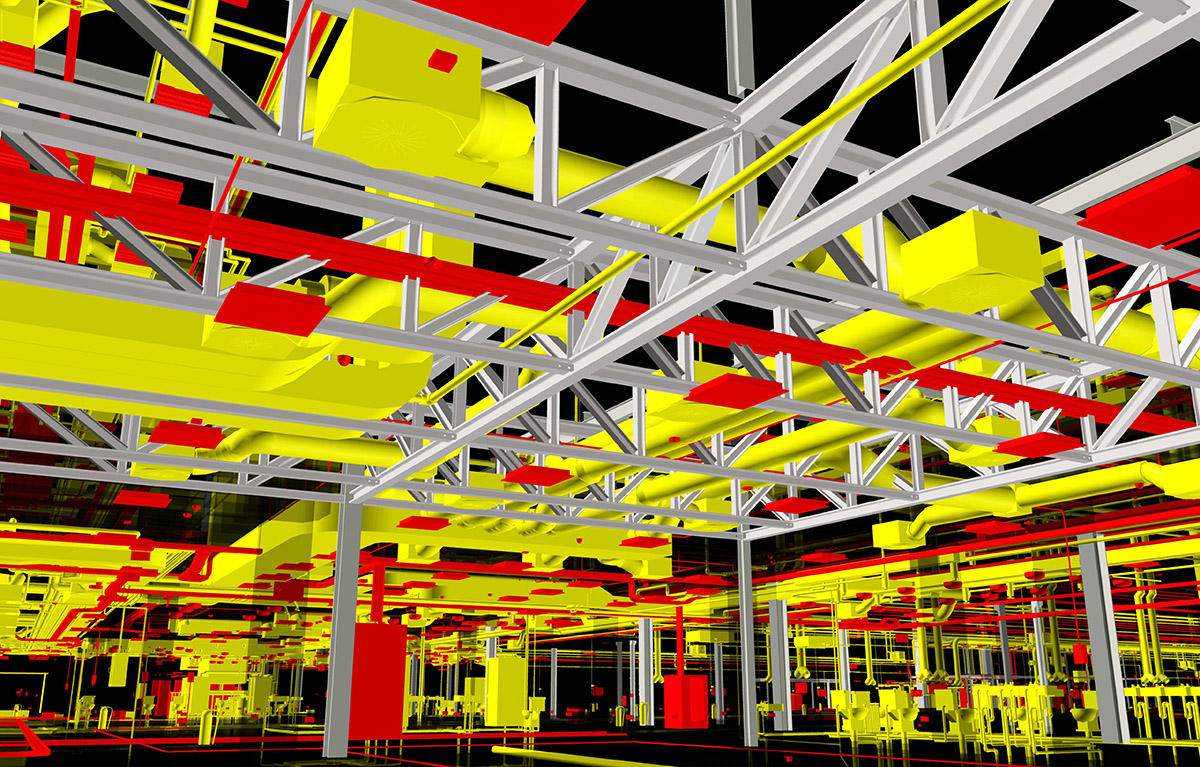Submitted by Antonello Magliozzi
Umberto Alesi on how the BIM manager is shaping Italian design
Italy Architecture News - Dec 24, 2018 - 03:27 8216 views

"The acronym BIM - Building Information Modeling - has become very popular in the construction world and this, as often happens with words that become fashionable, is leading to some misunderstandings," says Umberto Alesi, Italian architect, BIM Manager and pioneer in adopting digital technologies for over 20 years.
Often, it is confused for a software with its own methodology; but the BIM acronym is in reality "a method composed by processes and activities”. "These processes are facilitated, or better yet enabled, by digital technologies and software applications that have different features and functionality that can interact with each other." It therefore represents a new evolutionary phase of design with "the transition from a predominantly analogue to a digital approach," says Alesi.
Bim was born as "a response to the problem of poor productivity in the construction sector" It has over time evolved and has become an integral part of "a larger phenomenon known as: Fourth Industrial Revolution. Building Information Modeling is nothing more than a piece of the great digital revolution in the construction sector. It has had an important role also in Italy, although with different characteristics and speeds than those of other countries," Alesi comments to World Architecture Community in an exclusive interview.

Office buiding - Ancona, Alesi design. Image © Alesi
Umberto Alesi, RIBA and RICS Chartered, is member of BIM working groups of both the National Council of Italian Architects, and of Architects' Council of Europe. Together with colleagues from the Bim Advisory Group of RICS in Italy, Alesi has curated The Italian edition of the "International Guide for the implementation of BIM Systems", published in London by the Royal Institution of British Surveyors, in 2016. He holds training courses on "Building Information Modeling" at the Politecnico di Bari. He is strongly engaged in spreading design culture on BIM systems in a simple and understandable way. An awareness and mentoring action aimed at Italian financial investors and colleagues in the design sector. He's Country Bim Leader and Bim Manager for Arcadis Italy.

Omet, Studio Tentori design. Image © Alesi, Arcadis Italia
Alesi describes BIM through its goal of "allowing to build a virtual prototype of the building, a kind of ‘digital soul’ that will accompany the building itself until the end of its life cycle, regardless of the size of project”. BIM provides many competences "through collaboration, communication methods and approaches to the project" in a real "teamwork". “It offers a strategy which shapes the entire work team. Just like in a sports team, where there are well-defined roles, and never single players able to play multiple roles. Thus, alongside the functions of classical design related to disciplines: architectural, structural, systems, etc., in this team finds room a new figure linked to the Anglo-Saxon culture of Project Management. The BIM Manager, with the responsibility of "Shooting the Ball " at center field, to be able to manage and oversee the entire integrated design process”.

Omet, Studio Tentori design. Image © Alesi, Arcadis Italia
In this context, Alesi highlights how the BIM Manager, in addition to managing the project through modeling, three-dimensional representation of buildings and infrastructures, which is "a necessary but not sufficient condition", “he must mainly focus on the informative content of the model itself, that represented by the word: "Information", the “I” of the acronym BIM. This is the most revolutionary aspect of the design methodology: "Information". The successful system which has allowed to manage complex projects like the Guggenheim of Bilbao, entailing a design endowed with " sculptural forms, modeling, complex surfaces”. A design that needed complete control of all building and design aspects. A concept, as Alesi highlights, distant from “the widespread fear among all architects, that BIM mortifies creativity or can encourage a certain repetitiveness”. BIM is indeed: "an indispensable aid already in the conceptual phase, because it drives to the immediate relation with the design's constructive elements and not with those of abstract forms." In fact, "it is not only a management tool, but an advanced method for the control of the project and the management of the building."

Office buiding - Ancona, Alesi design. Image © Alesi
However, many do not know how the BIM team really works. What's the concrete role of the Manager within the project team, as well as that of the BIM Coordinator, the BIM Specialist and BIM Modeler. Also what are the team’s costs, and finally what are the concrete advantages to the entire design process? Many Italian companies are starting to experience today the effectiveness of BIM management, they are in fact understanding how to insert this actor in their own design departments and are experiencing how to integrate the potential of its management value added with those of other professionals. It is a path for many just started, which requires a cultural and economic commitment.

Office buiding - Ancona, Alesi design. Image © Alesi
BIM’s revolutionary impact, is in decreasing the economic and temporal commitment required for the planning and in implementation phase of the developed and executive project. A more agile approach than the traditional 2D CAD workflow with an undoubted overall advantage in the management of the costs related to the life cycle of the building design, the construction work at the jobsite, and the operation and maintenance of the building itself.
In Italy, a conservative and skeptical country with a prolonged economic downturn, benefits greatly from the commitment of an innovative architect of the caliber of Mr. Alesi who, on the basis of his professional clout and international reach, can affect the rooting of sizeable innovative investments in the sector and obtain long-term benefits.
In 2014, indicated by the Royal Institution of Chartered Surveyors (RICS), and as recalled by Umberto Alesi during the interview: "BIM technologies already reached high adoption rates of circa 70% in the USA, 50% in the United Kingdom, 40% in Australia and 25% in Middle East (led by the Gulf countries like Dubai and Qatar) ". In Italy, the phenomenon presents a greater delay, where we can forecast good growth only in the coming years, "which will be guided by the Government with specific actions, according to the Top-Down scheme". “The recent amendment of the procurement Code in implementing the EU Directive 24/2014, introduced indeed the obligation of BIM procedures, albeit by degrees and starting from 2019 with the largest projects.”

Office buiding - Ancona, Alesi design. Image © Alesi
"It is interesting, however, to note that in Italy there is also a spontaneous buttom-up initiative, due to the interest in BIM by large private developers who, in fact, were the first to adopt this method." It is therefore realistic to say that, from now on, but especially in the coming years, Italy will see the development of the "Fourth Industrial Revolution" in the foreground and will see BIM growing considerably in the integrated design of both Public and private procurement."

Omet, Studio Tentori design. Image © Alesi, Arcadis Italia
In this scenario, ideally, what will be the architect’s role? How will the construction and architecture of the project change and improve in Italy? Alesi says that: "The type of architect who will work using the BIM methodology, will be the only one who will remain relevant. He will this so by: collaborating, communicating, and sharing". In construction and architecture "collaboration must be among all participants in the process, starting from the client to the project owner. Stakeholders collaboration will require "a transparent communication of information". "The classic business models of construction, those that exploit information asymmetries, will tend to disappear around the new role of the architect. On the other hand, the models that will favor the sharing of information, the "project" and its "ownership" will be affirmed. In this context, the architect must therefore guarantee, beyond his creative and technical role, the development of a connective tissue of information at all levels." In this regard, Alesi mentions Mario Carpo in The Second Digital Turn: “In such instances, architectural authorship might take the form of some consensual “leadership,” curiously resembling the organization of labor that prevailed in late-medieval building sites before the rise of Alberti’s modern authorial paradigm”.

Omet, Studio Tentori design. Image © Alesi, Arcadis Italia
Alesi uses this approach for his Italian projects. Regarding his personal experience, he tells us that: "I have had the good fortune to combine theoretical experience, in professional and academic institutions, with private practice in a large corporation where BIM has been applied for many years." He says: "our customers are mainly large industrial groups, but recently we found some interest in BIM also by medium enterprises, which are the backbone of the Italian industrial network." For the Omet Project, Alesi mentions that "the key for success was the collaboration and the involvement of the client, throughout the process: from the approach to the operative phase". "For example in the design phase, 25 people from different Arcadis locations in Europe were involved and collaborated in the cloud simultaneously on the same files. In This scenario, “my job as BIM Manager was to set collaborative rules, both procedural and technological. Then through the information means of the BIM Execution Plan and the continuous coordination of all stakeholders it was possible to align the project towards the Owner Project Requirements, as established in the Bases of Design. That was my job!"
Read the full transcript of our interview with Umberto Alesi below:
Antonello Magliozzi: Umberto, Italy discovered BIM after other countries such as the USA, the United Kingdom and Germany had already started an implementation process. Tell us briefly the mindset, culture and context in which BIM is born and spread itself internationally?
Umberto Alesi: In 2014, as indicated by the Royal Institution of Chartered surveyors (RICS), BIM technologies were already adopted for about 70% in the USA, 50% in the United Kingdom, 40% in Australia and 25% in Middle East (led by the Gulf countries like Dubai and Qatar). Significant experiences are also recorded in Singapore and in general in India and the Far East. At international level, , to encourage the development of BIM some governments have set ambitious targets, in the medium term. According to scholars Kassem and Succar, Bim's diffusion drivers mainly follow three schemes: Bottom-Up, when the drive to innovation comes from the bottom of the chain, from small operators. This is Australia's case, for example. Middle-Out, when innovation is influenced by large companies or by category organizations. It's something like what's happening in the US. Top-Down, when innovation is driven by the government with specific actions, such as in the UK, where since 2016 the BIM is mandatory for all public procurement, or the Dubai municipality, where since 2013 the BIM is mandatory for major projects.
Antonello Magliozzi: Regarding BIM’s use what difference do you see between Italy and other countries that play an avant-garde role in the sector?
Umberto Alesi: Italy is rapidly bridging the gap with the Scandinavian countries, which started first in Europe, along with the United Kingdom. In recent years BIM has been imposed as a benchmark at global level. The publication of a national standard for standardization of BIM procedures (ISO UNI 11337), which collects the best of international experiences, is being completed. Therefore, Italy is now aligned with the methodological processes of BIM, although it must be said that these processes are not yet used in the practice of design by all operators. For a widespread development like that of the avant-garde countries, I could say that it is still necessary to complete a "generational turnover".
Antonello Magliozzi: Setting a legal procedure is a growing sensitive matter in recent years. This is also demonstrated by the Italian normative and legislative evolution. What legal rules have enshrined the importance of BIM and why?
Umberto Alesi: Italy will follow a top-down setting. The recent amendment of the procurement Code in implementing the EU Directive 24/2014, introduced indeed the obligation of BIM procedures, albeit by degrees and starting from 2019 with the largest projects. Interestingly, however, there is also a spontaneous initiative, from the bottom, due to the interest in BIM by large private investors who were in fact the first to adopt this method.
Antonello Magliozzi: Would you explain to those who do not know what distinguishes the BIM Manager from another project manager?
Umberto Alesi: BIM is a response to the problem of poor productivity of the construction sector through methods and approaches of collaboration and communication, we could say through a "team play". The complexity of the projects in the construction world, regardless of the size of the buildings, puts many competences in the field. A strategy shaping the entire work team, as in a sports team, where there are well-defined roles, and never single players able to play multiple roles. Thus, alongside the functions of classical design related to disciplines: architectural, structural, systems, etc., in this team finds place a new figure linked to the Anglo-Saxon culture of Project Management, the BIM Manager, with the responsibility of "Shoot the Ball " at the center field, to be able to manage and oversee the entire integrated design process. In this way he manages the digitization processes, also operating at the level of control and general coordination of the work. More simply could be said that the BIM Manager and his staff allows to build a virtual prototype of the building, a kind of “digital soul” that will accompany the building itself until the end of its life cycle.
Antonello Magliozzi: Often the means get confused with the goals. We might say we confuse the cause with the effect. Is it true that BIM is often associated with the mere application of software?
Umberto Alesi: The acronym BIM has become very popular in constructions' world and this, as often happens with words that become fashionable, "is leading to some misunderstandings. The first one, as you have highlighted, is that it is only a change of software application. BIM is in reality "a method composed by processes and activities. These processes are facilitated, we could say enabled, by digital technologies and software applications that have different features and functionality that can interact with each other
Antonello Magliozzi: What are the other misunderstandings that have been created around the BIM?
Umberto Alesi: For example, whether it's just a 3d model. A BIM model, on the other hand, is a centralized digital repository of information about the physical and functional aspects of a building or infrastructure. BIM, in fact, is the construction of a virtual prototype that allows you to make more conscious decisions about building and the final performance of the construction. This prototype is created through a collaborative process that uses specific digital tools. One of the necessary but insufficient characteristics of these instruments is to use the three-dimensional representation of buildings and infrastructures. A BIM model, therefore, besides being 3d must have an informative content, hence the centrality of the "I" of information contained in the acronym. Another misunderstanding that I would like to dispel is the fear, widespread above all among architects, according to which BIM mortifies creativity or can encourage a certain repetitiveness. In reality, the first real development of BIM took place in the 1990s to govern the complexity of projects such as the Guggenheim in Bilbao. Projects involving sculptural forms, modeling, complex surfaces, find in BIM an indispensable aid already in the conceptual phase, since they are immediately compared with constructive elements and not with abstract forms. BIM is not just a management tool but an advanced method for project control and construction management.
Antonello Magliozzi: Is this therefore a paradigm shift?
Umberto Alesi: Yes, we have to understand that we are facing a new evolutionary phase of design with "the transition from a predominantly analogue to a digital setting". All this fits into a larger phenomenon that is known as: Fourth Industrial Revolution. Building Information Modeling, is nothing more than a piece of the great digital revolution in the construction industry. For this reason, thinking about the BIM only in terms of software tools is misleading as it is reductive the analogy that wants the current shift from CAD to BIM as the equivalent of that, occurred in the years ' 90, from manual design to CAD. In fact, today the transformation is not only about tools of representation, as happened in the transition from manual design to CAD, but it concerns all the processes of production, management and fruition, of the building and of the city.
Antonello Magliozzi: How does this change influences the architect’s role?
Umberto Alesi: I would say that the key words in BIM are: collaboration, communication, sharing. Collaboration between all the participants in the process starting from the customer. Cooperation, to be fully realized, requires a transparent information communication. Therefore, the classic business models of construction, those that exploit information asymmetries, will tend to disappear around the new role of the architect. On the other hand, the models that will favor the sharing of information, the "project" and its "ownership" will be affirmed. In this context, the architect must therefore guarantee, beyond his creative and technical role, the development of a connective tissue of information at all levels.
To answer the question, I would also like to mention the historian and architecture critic Mario Carpo who in The Second Digital Turn says: “In such instances, architectural authorship might take the form of some consensual “leadership,” curiously resembling the organization of labor that prevailed in late-medieval building sites before the rise of Alberti’s modern authorial paradigm.”
Antonello Magliozzi: Can you describe your management experience by referring to a BIM project where you performed a coordination function?
Umberto Alesi: I have had the good fortune to combine theoretical experience, in professional and academic institutions, with private practice in a large corporation where the BIM has been doing for real for many years. Our customers are mainly large industrial groups, but recently we found some interest in the BIM also by the medium enterprise, which is then the backbone of the Italian industrial network.
We recently completed the design phase of an industrial building for the Omet group in Lecco (IT), which confirmed the validity of the Bim method even in projects below the 10 million euros of work amount. I could say that in this project the keyword coincided with the collaboration and the involvement of the client, throughout the process: from the approach to the operative phase. In this project experience we have seen both a modern cultural approach of management and the direction of the customer, and a daily attention towards the evolution of the design process. Useful attitude because it has contributed appreciably to the construction of a tool of fundamental utility for the successive phases of the life cycle of the project.
The Omet project, in the design phase, has involved about 25 people from different Arcadis locations in Europe, who have collaborated in the cloud simultaneously on the same files. In This scenario, my job as BIM Manager was to set collaborative rules, both procedural and technological. Then through the information means of the BIM Execution Plan and the continuous coordination of all stakeholders it was possible to align the project towards the Owner Project Requirements, as established in the Bases of Design. That was my job!
Top image courtesy of Umberto Alesi
